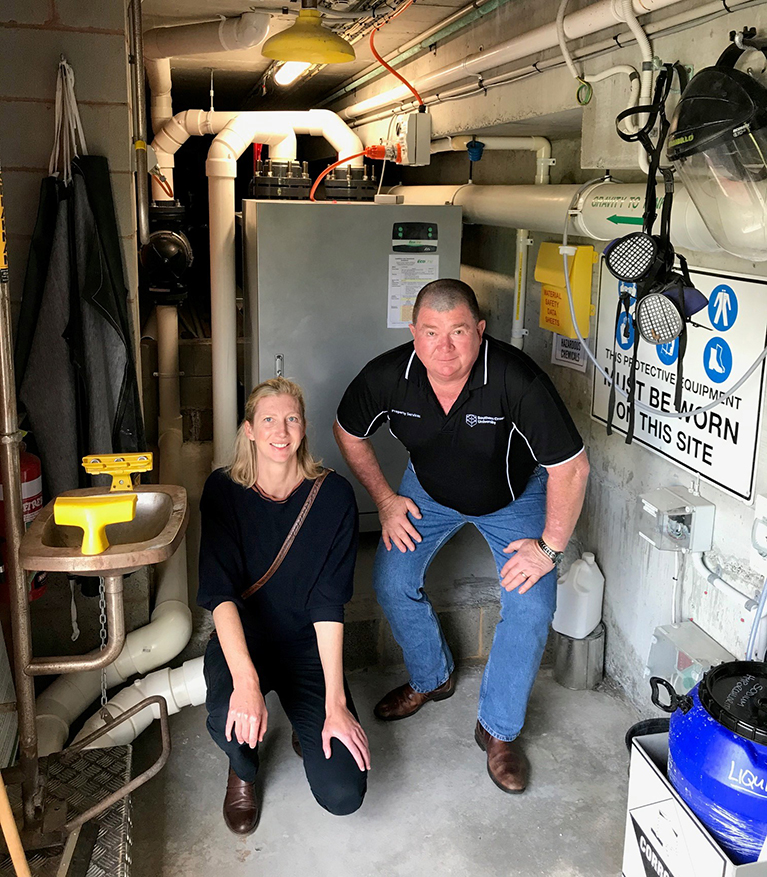University’s water efficiency set to potentially fill seven Olympic swimming pools
Categories
Share
/prod01/channel_8/media/scu-dep/news/images/2021/water-sport-recreation-pool-leisure-fitness-749542-pxhere.com-720X475.jpg)
Saving almost seven Olympic swimming pools’ worth of water is no easy feat, yet Southern Cross University is on track after introducing new water efficiency measures.
The University sought advice from experts at Rous County Council and the Australian Sustainability Institute to achieve the potential annual water savings, which equate to 17 megalitres, for the Lismore campus.
“Our team is ecstatic with the results, as well as water savings; we have also reduced our risk and maintenance costs,” said Ms Danika Head, Director of Property Services at Southern Cross University.
“This project has not only resulted in significant water savings but has reduced chemical handling for our staff and improved the health and safety of our operations.”
In recognition of Southern Cross’s commitment to water efficiency and sustainability while achieving significant water savings, Rous County Council is now featuring the University in promotion of its Sustainable Water Partner Program.
Rous County Council General Manager, Phillip Rudd, said: “This partner project is a positive example of identifying water saving projects that are financially viable with a strong return on investment.
“Ongoing monitoring is a significant achievement of this project, allowing the University to quickly identify any anomalies in their water consumption and make appropriate and timely changes.
“The Sustainable Water Partner Program is designed to support large businesses to investigate their water consumption and implement sustainable water savings projects,” said Mr Rudd.

Kirralee Donovan, Water Sustainability Officer at Rous County Council, with Geoff Cottee, Southern Cross University's Manager of Capital and Minor Works, inspect the backwash reduction project at the Fitness Centre & Pool (credit: Rous County Council).
The water saving projects
Rous Country Council, Southern Cross University and the Australian Sustainability Institute (ASI Consulting) embarked on the collaborative project to investigate the University’s water use, associated costs and a range of measures available to improve water efficiency.
This work was undertaken by collating and analysing water-use data and conducting an onsite walkthrough assessment to identify feasible upgrades and water saving projects. The onsite assessment, data gathering, and planning process was extensive considering the size, spread and number of water-using facilities onsite including a popular indoor pool complex (Fitness Centre & Pool), multiple plant nurseries, faculty buildings and other amenities.
The result was a comprehensive Water Saving Plan identifying priority activities and water saving projects that the University agreed were feasible, cost effective and provided the water saving benefits sought to reduce future costs.
These projects included:
- Installation of a freshwater chlorinator for the pool complex in the Fitness Centre & Pool to reduce volume of wastewater through backwashing;
- Installation of capillary action watering system in the tea tree nursery (and trials in other nurseries and gardens services on campus);
- Upgrades and repairs to amenity (shower and toilet) facilities;
- Monitoring and managing water leaks and the integration of software and water monitoring systems currently in place (SUMS and Innotech monitoring).
The Water Saving Plan identifying these projects was fully funded through Rous County Council’s Sustainable Water Partner Program.
Water efficiency and cost savings
Southern Cross University prioritised works based on the water savings as well as operational considerations. The installation of a freshwater chlorinator for the indoor pool – a backwash reduction project – was a priority action. This work was planned and implemented by the University with financial support through the Sustainable Water Partner Program.
Before and after monitoring of the pool demonstrates a significant reduction in water use. The forecast potential water saving of 17 megalitres annually represents a saving of $67,000 per annum, with significant chemical and energy savings on top of this.
Monitoring continues with additional projects being planned and implemented as time and resources allow.
Media contact: Sharlene King, media office at Southern Cross University, 0429 661 349 or scumedia@scu.edu.au

/prod01/channel_8/media/scu-dep/current-students/images/Coffs-harbour_student-group_20220616_33.jpg)
/prod01/channel_8/media/scu-dep/current-students/services/counselling/images/RS21533_English-College-Student_20191210_DSC_6961.jpg)
/prod01/channel_8/media/scu-dep/study/scholarships/images/STEPHANIE-PORTO-108-2.jpg)
/prod01/channel_8/media/scu-dep/study/arts-and-humanities/images/RS20958_Chin-Yung-Pang-Andy_20190309__79I5562-960X540.jpg)
/prod01/channel_8/media/scu-dep/experience/images/SCU-INTNL-STUDY-GUIDE-280422-256.jpg)
/prod01/channel_8/media/dep-site-assets/component-library/screenshots/online-1X1.jpg)
/484x0:1516x1032/prod01/channel_8/media/scu-dep/news/images/2024/Meiyi-Li.png)
/484x0:1516x1032/prod01/channel_8/media/scu-dep/news/images/2024/changchun.png)
/302x0:1309x1007/prod01/channel_8/media/scu-dep/news/images/2024/GCA-LM-6858-b.jpg)
/885x0:4423x3538/prod01/channel_8/media/scu-dep/news/images/2024/Jordan-Ivey-a-.jpg)
/484x0:1516x1032/prod01/channel_8/media/scu-dep/news/images/2024/dylan-3.png)
/712x0:3544x2832/prod01/channel_8/media/scu-dep/news/images/2024/Johanna-Byrne-a.jpg)
/514x0:1487x973/prod01/channel_8/media/scu-dep/engage/alumni/images/JN_01061-2024AIA-AnnouncementCampaign-Header-2000X1032px-FA.jpg)
/484x0:1516x1032/prod01/channel_8/media/scu-dep/news/images/2024/ashok-2.png)
/500x0:2500x2000/prod01/channel_8/media/scu-dep/news/images/2024/KHolmes_KevinFraney_3.jpg)
/584x0:2084x1500/prod01/channel_8/media/scu-dep/news/images/2024/OT-students-1.jpg)